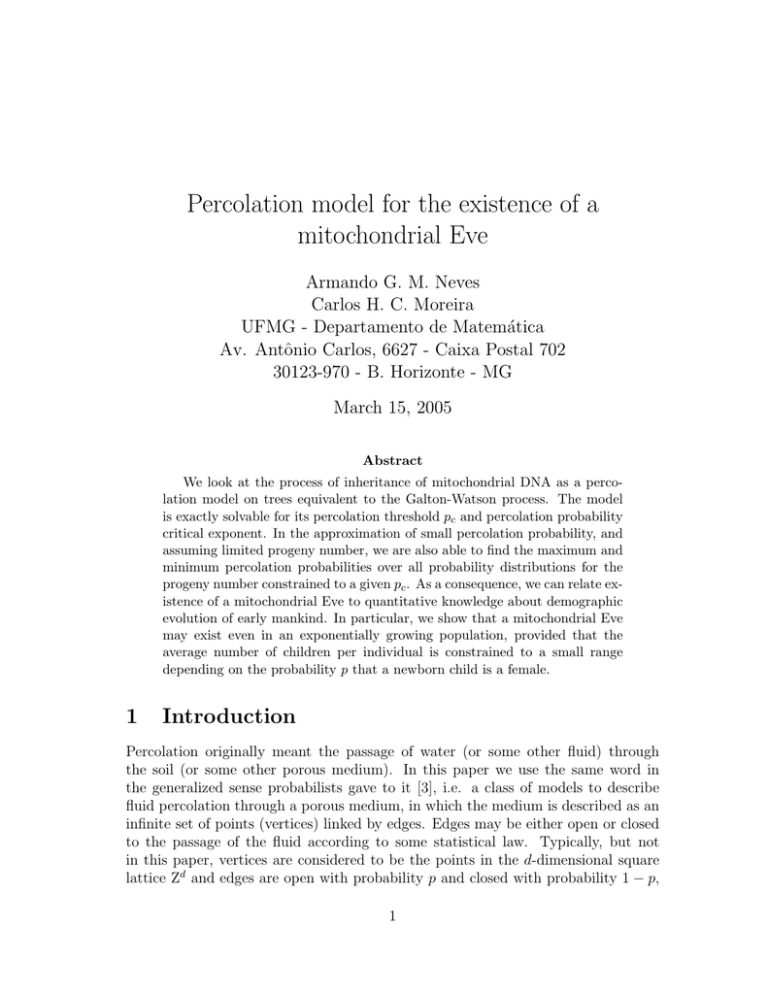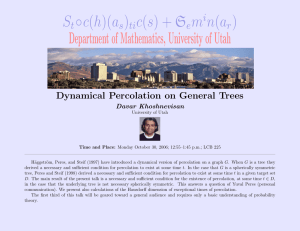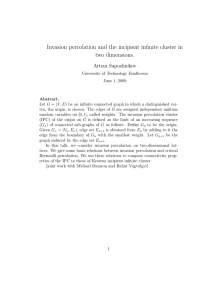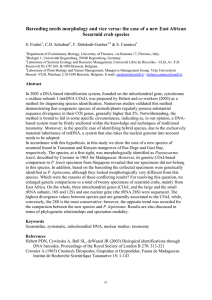Percolation model for the existence of a mitochondrial Eve
advertisement

Percolation model for the existence of a
mitochondrial Eve
Armando G. M. Neves
Carlos H. C. Moreira
UFMG - Departamento de Matemática
Av. Antônio Carlos, 6627 - Caixa Postal 702
30123-970 - B. Horizonte - MG
March 15, 2005
Abstract
We look at the process of inheritance of mitochondrial DNA as a percolation model on trees equivalent to the Galton-Watson process. The model
is exactly solvable for its percolation threshold pc and percolation probability
critical exponent. In the approximation of small percolation probability, and
assuming limited progeny number, we are also able to find the maximum and
minimum percolation probabilities over all probability distributions for the
progeny number constrained to a given pc . As a consequence, we can relate existence of a mitochondrial Eve to quantitative knowledge about demographic
evolution of early mankind. In particular, we show that a mitochondrial Eve
may exist even in an exponentially growing population, provided that the
average number of children per individual is constrained to a small range
depending on the probability p that a newborn child is a female.
1
Introduction
Percolation originally meant the passage of water (or some other fluid) through
the soil (or some other porous medium). In this paper we use the same word in
the generalized sense probabilists gave to it [3], i.e. a class of models to describe
fluid percolation through a porous medium, in which the medium is described as an
infinite set of points (vertices) linked by edges. Edges may be either open or closed
to the passage of the fluid according to some statistical law. Typically, but not
in this paper, vertices are considered to be the points in the d-dimensional square
lattice Zd and edges are open with probability p and closed with probability 1 − p,
1
independently. Besides fluid percolation, percolation models have also found other
applications, such as the spread of diseases in a population or disordered electrical
networks [9].
One is usually interested in calculating the percolation probability, defined as
follows. Choose some vertex O to be the origin and some configuration of open
and closed edges. Consider the cluster of all vertices connected to the origin by
some path of open edges. We say that this configuration percolates if the cluster
of vertices connected to O is infinite. The percolation probability is defined as the
probability θ(p) of the percolation event over all configurations.
Percolation models attract so much attention because θ(p) usually exhibits a
“second-order phase transition”: there exists a percolation threshold pc such that
θ(p) is strictly zero for p < pc and positive for p > pc . They look thus like toy models
for Statistical Mechanics and in fact many techniques developed in percolation may
be adapted to Statistical Mechanics and vice-versa. But percolation models may be
not at all trivial [9].
As the reader is going to see in a while, the percolation model we shall develop for
the existence of a mitochondrial Eve is one in which the medium is a genealogical
tree, the edges are parental relationships and the “fluid” is mitochondrial DNA
(mtDNA). Before we say more on that, let us briefly review the very basic facts
about mtDNA and the mitochondrial Eve.
Although most of the genetic information in higher animals is located at cells’
nuclei, some DNA may be found in the subcellular organelles called mitochondria.
These structures are present in large numbers in nearly every cell and play a key
role in metabolism. mtDNA is very short; in humans it consists in only 16,569 base
pairs carrying the information for 37 genes. But mtDNA of humans and many other
species has been the object of recent intensive research [1], both for its availability
(because mitochondria are so numerous) and peculiar inheritance mechanism. Unlike nuclear DNA, which is inherited in equal parts from mother and father, mtDNA
is inherited only from the mother. So, in the absence of mutations, the mtDNA of
an individual would be identical to the mtDNA of a single ancestor out of his or her
2n ancestors n generations before, namely the mother of the mother . . . of his or her
mother.
This simple feature allows one to use mtDNA comparisons among living individuals to look far back in time and draw conclusions about the separation of subpopulations in one species or the speciation process, in which several extant species
may descend from one extinct species [1].
An experiment performed in the late 80’s brought press popularity to mtDNA.
By examining mtDNA of 147 living humans and taking into account mutations,
Cann, Stoneking and Wilson asserted in [5] that mtDNA of all living humans could
be described as mutations in the mtDNA of a single woman. As we would all be
her descendants, this woman was called the mitochondrial Eve. By using known
2
mutation rates and exploiting geographical correlations, it could be inferred that
the mitochondrial Eve has lived in Africa more or less 200,000 years ago.
The mitochondrial Eve should not be confused with the biblical Eve. Unlike the
latter, the mitochondrial Eve is not supposed to be the only woman living at her
time. Many other men and women contemporary to her have probably left traces
of their nuclear DNA in modern humans, see e.g. [7] or [6] for proofs of this in the
case of a population with a fixed size. But they left no trace of their mtDNA.
The time and the place in which the mitochondrial Eve lived are considered a
strong evidence for the Out of Africa model for the origin of our own species [16].
This model proposes that modern humans, Homo sapiens, evolved in Africa and subsequently colonized the rest of the world replacing archaic forms such as the Homo
neanderthalensis and the Homo erectus, without mixing with them. The competing
Multi-regional Evolution model [15] suggests instead that modern humans evolved
from archaic forms concurrently in different regions of the world, with occasional
genetic flow among regions, necessary to preserve uniqueness of our species.
In order to explain why all mtDNA lineages stemming from women coeval to
the mitochondrial Eve were extinct, Brown proposed in [4] that a severe bottleneck,
in which human population dropped to only a few individuals, must have existed
after the mitochondrial Eve. This is a very strong hypothesis, considering that human population, at least in historical times, has been steadily growing, and that
achievement of important technological developments in prehistory made possible
for humans to spread all over the world. In [2] Avise, Neigel and Arnold argued
that a prehistorical population bottleneck is not strictly necessary by showing that
stochastic mtDNA lineage extinction can be rapid enough even in stable-sized populations.
Our main purpose in this paper is to show that the existence of a mitochondrial
Eve can be explained even if the population grows exponentially, provided that the
growth rate is not too large. Although our model and formalism are similar to
the ones in [2], we show that one solution discarded there is biologically plausible.
We are also able to generalize their methods to arbitrary progeny distributions and
to display the model explicitly in the language of an exactly-solvable percolation
problem.
2
Percolation model for mtDNA inheritance
The assumptions in our model for mtDNA inheritance are the following:
(A1) Generations are nonoverlapping.
(A2) The numbers of children for each individual are statistically independent and
identically distributed random variables assuming value r ∈ {0, 1, 2, . . .} with
probability Qr . The values for the Qr ’s are time- and population size-independent.
3
(A3) A newborn child is a female with probability p and a male with probability
1 − p. The value for p is also time- and population size-independent.
(A4) There always exist males enough to mate with all females.
Assumption (A1) grants some formal simplicity to the model. (A2) disregards
interactions that might come from a number of different sources such as fertility
correlations among members of a family, competition (for food supplies, mating
partners, etc), cooperation and geographical aspects. One natural attempt to improve the model would be to make the Qr ’s dependent on the total population, thus
accounting for saturation effects. Although feasible in computer simulations, that
would ruin the linearity on which our theoretical analysis relies. The time independence of the Qr ’s is also questionable because it disregards the effects of climatic
changes. However this assumption may be adequate over an initial period of time
long enough to produce most of the lineage extinctions. (A3) adds some generality
to the model with respect to the one in [2], in which p = 1/2. Usually p varies from
species to species and even for modern humans p ≈ 0.488, strictly less that 1/2 [12].
This fact will be of quantitative relevance in our results. (A4) is assumed, since we
do not keep track of the male population. It is a reasonable assumption because
males from all concurrent mitochondrial lineages may participate in any single one,
without interfering in the mitochondrial inheritance. Also, even for p only slightly
less than 1/2, the results in this paper will show that male extinction is much less
probable than female extinction for humans.
Consider now the genealogic tree of an ancestral woman constructed according
to the above assumptions. By genealogic tree we mean the graph obtained by
considering as vertices the ancestral herself, located at the origin O and all her
descendants after an infinite number of generations, drawing edges joining each
father or mother to their children of either sex. Define as open any edge linking a
mother to her children and closed all other edges. It is clear that the mtDNA lineage
of the woman will survive if and only if the configuration of open edges percolates.
Therefore mtDNA inheritance may be posed as a problem of edge percolation in a
tree graph, in which edges are open with probability p and closed with probability
1 − p. Unfortunately, unlike most percolation models, edges may not be statistically
independent because any child with both parents in the graph must appear twice,
separately linked to each of the parents. An example is shown in figure 1(a).
In order to overcome the dependence problem, we define the female genealogic
tree (FGT) as the tree obtained after stripping the genealogic tree of all descendants
of male individuals, see figure 1(b). In the FGT all edges are open and statistically
independent. Percolation in the complete genealogic tree is equivalent to the corresponding FGT being infinite generations long.
4
male
female
a
b
Figure 1: (a) Example of a genealogic tree of the type considered in this paper. The
individuals enclosed in the rectangle have both their father and mother in the tree,
exemplifying the possibility of statistically dependent edges.
(b) The female genealogic tree corresponding to the complete tree in (a).
If we denote as qr , r = 0, 1, 2, . . ., the probability that an individual has r children
of female sex, then
µ ¶
∞
X
k
Qk
pr (1 − p)k−r .
(1)
qr =
r
k=r
The process of growing the FGT under the above assumptions, each female vertex
originating r branches with probability qr , is known as the Galton-Watson processes
[10]. It was originally introduced to study the problem of extinction of family names.
Let θn (q0 , q1 , . . .) be probability that the FGT is at least n generations long. We
denote by θn ≡ 1 − θn the probability that the FGT is long n − 1 generations or
less. The end of the FGT in n − 1 or less generations may happen either if the
woman in its origin has no daughters (with probability q0 ), or if she has b daughters,
b = 1, 2, . . ., each of them having a female genealogy at most n − 2 generations long
b
(with probability qb θn−1 ). Thus,
θn = S(θn−1 ) ,
(2)
S(x) = q0 + q1 x + q2 x2 + . . .
(3)
where
is the generating function for the probability distribution of the number of daughters.
The initial condition to be used in conjunction with (2) is θ1 = q0 .
The normalization of the qr ’s implies that 1 is a fixed point of S. Since S is nondecreasing with all derivatives non-decreasing in [0, 1], it will have a second fixed
point θ ∈ [0, 1) if and only if S 0 (1) > 1. There are no other fixed points in [0, 1].
Regarding attractiveness [8], we may have three different regimes:
(i) If S 0 (1) < 1, then 1 is the only fixed point and it is attractive.
5
(ii) If S 0 (1) > 1, then 1 is a repulsive fixed point, whereas θ is attractive.
(iii) If S 0 (1) = 1, then 1 is again the only fixed point in [0, 1] and it is weakly
attractive.
If Θ ≡ limn→∞ θn is the percolation probability, then
½
0, if S 0 (1) ≤ 1
Θ =
,
θ, if S 0 (1) > 1
(4)
P
where θ ≡ 1 − θ ∈ (0, 1]. By writing S 0 (1) = ∞
r=1 r qr and using (1) we get that
0
condition S (1) > 1 may be written as p > pc . The percolation threshold pc is
pc =
with
N =
1
,
N
∞
X
r Qr
(5)
(6)
r=1
meaning the average number of children (of either sex) per woman. Regime (i) is
then the subcritical percolation regime (i.e. p < pc ), (ii) is supercritical (p > pc )
and (iii) is critical (p = pc ).
The value of θ in terms of the qr ’s may be obtained by solving S(θ) = θ. For
p > pc and p close enough to pc , we introduce what we shall call small percolation
probability approximation. In this case, an approximate value θa for θ is obtained
by replacing S by its Taylor polynomial of degree 2 around 1. We find
θ ≈ θa =
p − pc
µ ¶
.
P∞
r
2
pc p
Qr
r=2
2
(7)
If the critical exponent β for the percolation probability is defined by θ ∼ (p −
pc ) , then (7) gives β = 1. From the non-negativity of S 000 , it follows that θa is
actually a lower bound for θ.
The speed of convergence of θn to Θ, a useful parameter for simulation purposes,
follows from the mean value theorem of Calculus. In cases (i) and (ii) θn −Θ ∼ e−n/ξ
for large n, where, as usual, the correlation time
β
ξ = −1/ ln[S 0 (1 − Θ)]
(8)
diverges when p → pc . In the critical case (iii) exponential convergence is replaced
2
for large n.
by a much slower power law: θn ∼ S 00 (1)
n
6
3
Demographic considerations
Let W be the number of women coeval to the mitochondrial Eve. If different lineages
may be considered as independent, then the number r of lineages remaining after n
generations is a binomially distributed random variable with
µ
¶
W
Prob{r = m} =
θnm (1 − θn )W −m .
(9)
m
This approach was used in [2], where the authors concentrated on the probability
Πn for the survival of two or more lineages after n generations. For some specific
progeny distributions they found that in the supercritical regime Πn tends to a positive value as n → ∞; they considered this to be incompatible with a mitochondrial
Eve. The subcritical regime was also discarded because it leads to quick extinction. Instead, the critical regime was selected because with W = 1, 000 ∼ 10, 000 it
leads to Πn approaching zero in n ≈ 104 generations. Such values for W and n are
well within the range expected by geneticists and paleontologists. For p = 1/2, as
used in [2], the critical regime yields N = 2 and can only account for a stable-sized
population.
We shall now argue that for a range of values of N , the supercritical regime
also provides a biologically plausible solution for the existence of a mitochondrial
Eve in a growing population. We shall use W = 5, 000 and n = 104 , as suggested
for example in [14]. We also use p = 0.488, obtained from the standard figure of
105 male births per 100 female births, the modern human sex ratio at birth [12],
assuming that this ratio can be extrapolated to the times of early mankind.
From (9) we get that the expected number of surviving lineages after n generations is W θn . To be consistent with the existence of a mitochondrial Eve as an event
with a not too small probability, this number must not be much smaller or much
larger than 1. For illustration purpose, we take it between 1/2 and 2, implying θn
between 1/(2W ) and 2/W . In order to estimate the range of values for N consistent
with that, we first replace θn for θa given in (7). This approximation is valid as long
as two conditions are fulfilled. Firstly, the number of generations n must be so large
that θn is close to θ. Finally, the small percolation probability approximation must
hold in order that θ is close to θa . The latter is true, because θ is of order W −1 , a
small number if W = 5, 000. The former, θn ≈ θ, will be justified soon.
Also, for practical purposes we may truncate the series in the right-hand side
of (7) at some order M (limited progeny assumption). The problem of estimating
the maximum and minimum of θa for given N then becomes a standard linear
programming problem,
µ in¶which we must respectively minimize or maximize the
P
PM
P
r
r Qr = N , M
Qr under the constraints M
linear function r=2
r=1
r=1 Qr =
2
1 and 0 ≤ Qr ≤ 1 for r = 0, 1, . . . , M .
7
Percolation probability
2.0492
2.0502
2.0512
2.0502
2.0512
0.0005
0.0004
0.0003
0.0002
0.0001
2.0492
Mean number of children
Figure 2: Maximum and minimum values for θa as functions of N with M = 10.
Horizontal lines correspond to the values 1/(2W ) and 2/W for θa .
In figure 2 we show a plot of the maximum and minimum values for θa as functions of N , taking M = 10. The values for N consistent with existence of a mitochondrial Eve as a not very rare event are thus such that the maximum θa lies over
1/(2W ), which yields N > 2.0492, and the minimum lies below 2/W , which yields
N < 2.0510. For N in this range the probability that only one lineage survives is
approximately constant around 30% and the population will grow exponentially at
a non-negligible rate.
The value M = 10 for the maximum number of children is arbitrary. However
it turns out that the maximum values for θa become independent of M for M ≥ 3
and are obtained with Qr 6= 0 only for r = 2 or 3. On the other hand, the minimum
values for θa do depend on M and tend to 0 as M → ∞. Nonetheless, this minimum
value is attained when Qr = 0, r = 0, 1, 2, . . . , M − 1 and QM = N /M , which is
quite an artificial probability distribution for the number of children. We believe
that imposing realistic conditions on the Qr ’s would constrain even more the average
number of children consistent with existence of a mitochondrial Eve.
Results plotted in figure 2 assume, as already mentioned, that θn can be approximated by its limit θ when n → ∞. In other words, the results will be valid
provided n À ξ, where the correlation time ξ is given by (8). Although we do not
know how to give precise bounds to ξ independent of the progeny distribution, as
we did for θa , we noticed that it is fairly constant when N is fixed and the progeny
distribution varied. In particular, for the largest value N = 2.0510 compatible with
the existence of the mitochondrial Eve, ξ is of the order of 1,100 generations. As
geneticists assume that the mitochondrial Eve lived more or less 10,000 generations
ago, the approximation is justified for N = 2.0510. On the other hand ξ diverges
when N approaches 1/p. This means that the range of values for N compatible with
8
the Eve should be extended down to 1/p.
4
Conclusions and perspectives
We have proposed and solved a percolation model for mtDNA inheritance and lineage extinction compatible with the existence of a mitochondrial Eve in a growing
population. According to this model, a mitochondrial Eve is likely only if the mean
number of children per individual is constrained to a narrow range. The exact values for this range depend critically on the number of women W at the time of the
mitochondrial Eve, but not on the number of generations since then. Of course,
our model should be thought of as a simplified version of reality. We think it is
a valuable starting point for further work, including simulations of more realistic
models [13].
One tacit assumption in our analysis, supported by biologists, is that all W
original mtDNA lineages are equally fit, i.e. there is no natural selection acting on
lineage sorting. It also follows from our results that within the range of values for N
in which a mitochondrial Eve is likely, there is a probability of approximately 70%
that the number of surviving mtDNA lineages is different from 1. As this number
can also be 0, we may explain extinction of other hominid species which had existed
for some periods, if they had similar demography as our own species.
Returning to the two competing models on human origins, we should say that
existence of an African mitochondrial Eve only proves that a sizeable part of early
mankind did originate in that continent, but not the whole of it. mtDNA lineages
originated somewhere else may have simply become extinct, which in our model
appears as a highly probable event even in a growing population. We mean that
existence of an African mitochondrial Eve does not rule out the multi-regional evolution model.
While preparing this paper, we discovered another application for our methods.
Unlike most other animals, in which the sex of the offspring is genetically determined
(X and Y chromosomes in mammals, for example), the sex of the offspring in some
living reptile species depends on the temperature during egg incubation. Although a
definitive proof still lacks, Miller, Summers and Silber [11] conjecture that the same
sex determination by temperature might hold for dinosaurs. Should that be true,
a predominance of males could have arisen as a consequence of worldwide climate
change after the impact of a large meteor. By numerically solving a mathematical
model based on differential equations, they show that in this case dinosaur populations would decrease with time. If the sex skew were not too severe or lasted only
for a short time, populations would start growing again.
We notice here that our model can easily account for this phenomenon. In fact,
an increase in male proportion is equivalent to lowering the value of p, while pc is
9
held constant. On the other hand, the analysis carried out in [11] seems to disregard
the fact that even in the worst cases, populations would increase again after some
time. Here we see an important difference between their population modelling with
differential equations and our “discrete” model. Differential equations are deterministic because they use the mean behavior for all individuals in the population.
Extinction occurs in their model because of decrease in population to less than one
individual. On the other hand, our model accounts for statistical fluctuations. If
2 < N < 1/p, population will increase in average, but extinction will still happen
with positive probability due to statistical fluctuations. In other words, modelling
populations with differential equations is analogous to mean-field theories in Statistical Mechanics, which we know can lead to wrong results.
We finally note that as Monte Carlo simulations are being increasingly used in
Genetics, it is important to use the methods from the Physics of critical phenomena
to better understand results derived from these simulations.
References
[1] J. C. Avise. Mitochondrial dna and the evolutionary genetics of higher animals.
Phil. Trans. R. Soc. Lond. B, 312:325, 1986.
[2] J. C. Avise, J. E. Neigel, and J. Arnold. Demographic influences on mitochondrial dna lineage survivorship in animal populations. J. Molec. Evol., 20:99,
1984.
[3] S. R. Broadbent and J. M. Hammersley. Percolation processes i. crystals and
mazes. P. Camb. Philos. Soc., 53:629, 1957.
[4] W. M. Brown. Polymorphism in mitochondrial dna of humans as revealed by
restriction endonuclease analysis. Proc. Natl. Acad. Sci USA, 77:3605, 1980.
[5] R. L. Cann, M. Stoneking, and A. C. Wilson. Mitochondrial dna and human
evolution. Nature, 325:31, 1987.
[6] J. T. Chang. Recent common ancestors of all present-day individuals. Adv.
Appl. Probab., 31:1002, 1999.
[7] B. Derrida, S. C. Manrubia, and D. H. Zanette. Statistical properties of genealogical trees. Phys. Rev. Lett., 82:1987, 1999.
[8] R. L. Devaney. A First Course in Chaotic Dynamical Systems. Addison Wesley,
Reading, 1992.
[9] G. Grimmett. Percolation. Springer-Verlag, Berlin, 2nd edition, 1999.
10
[10] T. E. Harris. The Theory of Branching Processes. Dover, New York, 1989.
[11] D. Miller, J. Summers, and S. Silber. Fertility and Sterility, 81(4):954, 2004.
[12] C. Newell. Methods and models in Demography. John Wiley and Sons, Chichester, 1988.
[13] D. L. T. Rohde, S. Olson, and J. T. Chang. Modelling the recent common
ancestry of all living humans. Nature, 431:562, 2004.
[14] N. Takahata. Allelic genealogy and human evolution. Mol. Biol. Evol., 10(1):2,
1993.
[15] A. G. Thorne and M. H. Wolpoff. The multiregional evolution of humans. Sci.
Am., 266(4):76, 1992.
[16] A. C. Wilson and R. L. Cann. The recent african genesis of humans. Sci. Am.,
266(4):68, 1992.
11






